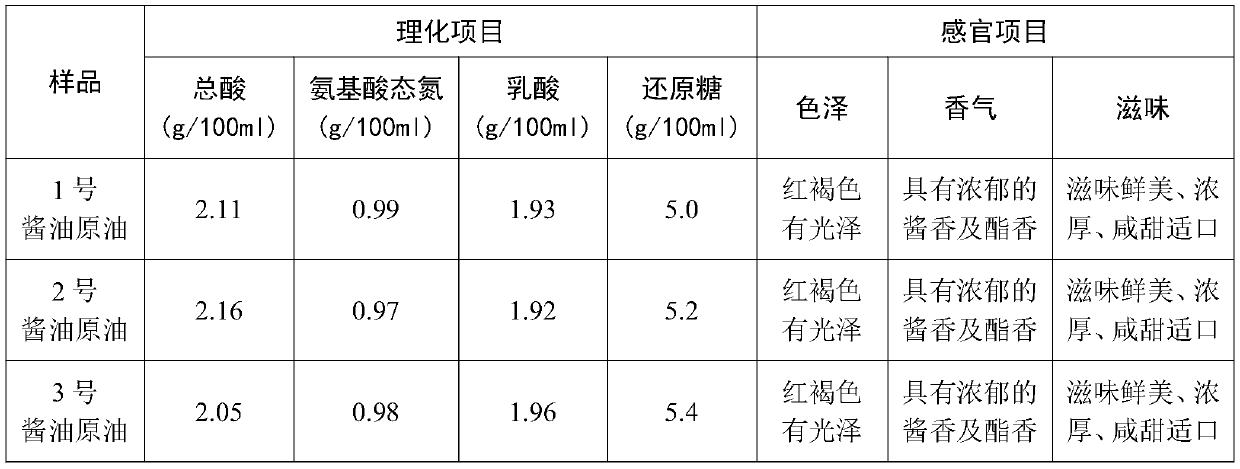Cantonese-style high salt and diluting soy sauce fermentation process
A technology of high-salt dilute soy sauce and fermentation process, which is applied in the field of condiment production, can solve the problems of lactic acid bacteria protein utilization rate and addition amount, which are rarely reported, and achieve the effects of delicious and thick taste, improved utilization rate, and rich sauce flavor.
- Summary
- Abstract
- Description
- Claims
- Application Information
AI Technical Summary
Problems solved by technology
Method used
Image
Examples
Embodiment 1
[0031] Cantonese-style high-salt dilute soy sauce fermentation process in this embodiment comprises the steps:
[0032] S1. Soybean pretreatment: after soaking 10.5 parts by mass of soybeans, put them in a cooking pot and cook until they are thoroughly cooked. The cooking conditions are as follows: the cooking temperature is 110-125°C, the pressure is 0.11-0.14Mpa, and the cooking time is 9±2mins. Then cool to 32.5-36.5°C, and crush the cooled cooked soybeans into soybean scraps through a roller crusher.
[0033] S2. Koji making: mixing soybean crushed material with 3.0 parts by mass of flour, adding 0.0050 parts by mass of strain powder, and then performing thick-layer ventilation to make koji to obtain Daqu. The koji making conditions are: 28°C-36°C, humidity 70%-95%, and incubation time 30-44h.
[0034] S3. Making moromi: adding brine to the obtained Daqu and mixing evenly, the amount of brine is 2.8-3.0 times the mass of the Daqu, to obtain moromi.
[0035] S4. Fermenta...
Embodiment 2
[0039] Cantonese-style high-salt dilute soy sauce fermentation process in this embodiment comprises the steps:
[0040] S1. Soybean pretreatment: after soaking 9.5 parts by mass of soybeans, put them in a cooking pot and cook until they are thoroughly cooked. The cooking conditions are as follows: the cooking temperature is 110-125°C, the pressure is 0.11-0.14Mpa, and the cooking time is 9±2mins. Then cool to 32.5-36.5°C, and crush the cooled cooked soybeans into soybean scraps through a roller crusher.
[0041] S2. Koji making: mix soybean crushed material with 4.0 parts by mass of flour, add 0.0045 parts by mass of strain powder and mix, then carry out thick-layer ventilated koji making to obtain Daqu. The koji making conditions are: 28°C-36°C, humidity 70%-95%, and incubation time 30-44h.
[0042] S3. Making moromi: adding brine to the obtained Daqu and mixing evenly, the amount of brine is 2.8-3.0 times the mass of the Daqu, to obtain moromi.
[0043] S4. Fermentation: ...
Embodiment 3
[0046] Cantonese-style high-salt dilute soy sauce fermentation process in this embodiment comprises the steps:
[0047] S1. Soybean pretreatment: After soaking 10.0 parts by mass of soybeans, put them in a cooking pot and cook until they are thoroughly cooked. The cooking conditions are as follows: the cooking temperature is 110-125°C, the pressure is 0.11-0.14Mpa, and the cooking time is 9±2mins. Then cool to 32.5-36.5°C, and crush the cooled cooked soybeans into soybean scraps through a roller crusher.
[0048] S2. Koji making: mix soybean crushed material with 4.0 parts by mass of flour, add 0.0045 parts by mass of strain powder and mix, then carry out thick-layer ventilated koji making to obtain Daqu. The koji making conditions are: 28°C-36°C, humidity 70%-95%, and incubation time 30-44h.
[0049] S3. Making moromi: adding brine to the obtained Daqu and mixing evenly, the amount of brine is 2.8-3.0 times the mass of the Daqu, to obtain moromi.
[0050] S4. Fermentation:...
PUM
 Login to View More
Login to View More Abstract
Description
Claims
Application Information
 Login to View More
Login to View More - R&D
- Intellectual Property
- Life Sciences
- Materials
- Tech Scout
- Unparalleled Data Quality
- Higher Quality Content
- 60% Fewer Hallucinations
Browse by: Latest US Patents, China's latest patents, Technical Efficacy Thesaurus, Application Domain, Technology Topic, Popular Technical Reports.
© 2025 PatSnap. All rights reserved.Legal|Privacy policy|Modern Slavery Act Transparency Statement|Sitemap|About US| Contact US: help@patsnap.com


